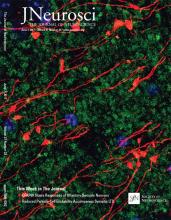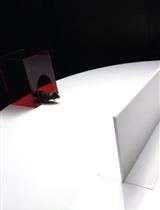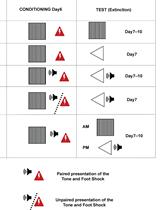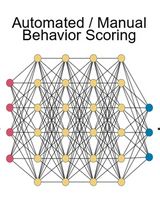- EN - English
- CN - 中文
Context-driven Salt Seeking Test (Rats)
情景驱动的大鼠寻盐测试
发布: 2018年04月05日第8卷第7期 DOI: 10.21769/BioProtoc.2456 浏览次数: 5983
评审: Beatriz CastroXi FengAnonymous reviewer(s)
Abstract
Changes in reward seeking behavior often occur through incremental learning based on the difference between what is expected and what actually happens. Behavioral flexibility of this sort requires experience with rewards as better or worse than expected. However, there are some instances in which behavior can change through non-incremental learning, which requires no further experience with an outcome. Such an example of non-incremental learning is the salt appetite phenomenon. In this case, animals such as rats will immediately seek out a highly-concentrated salt solution that was previously undesired when they are put in a novel state of sodium deprivation. Importantly, this adaptive salt-seeking behavior occurs despite the fact that the rats never tasted salt in the depleted state, and therefore never tasted it as a highly desirable reward.
The following protocol is a method to investigate the neural circuitry mediating adaptive salt seeking using a conditioned place preference (CPP) procedure. The procedure is designed to provide an opportunity to discover possible dissociations between the neural circuitry mediating salt seeking and salt consumption to replenish the bodily deficit after sodium depletion. Additionally, this procedure is amenable to incorporating a number of neurobiological techniques for studying the brain basis of this behavior.
Background
The salt appetite phenomenon was first discovered by Richter (1936), who found that rats began to immediately consume a 1% salt solution in greater quantities compared to water in a 2-bottle choice test following adrenalectomy and consequently bodily sodium depletion. More recently, Robinson and Berridge (2013) have shown that this immediate increase in salt-seeking behavior occurs to discrete salt-paired cues following sodium depletion in the absence of salt before it has been tasted as a desirable reward. In addition, adaptive salt-seeking has also been observed with contextual cues following sodium depletion (Stouffer and White, 2005).
In the brain, there is clear evidence that the central nucleus of the amygdala (Galaverna et al., 1993; Seeley et al., 1993; Tandon et al., 2012; Hu et al., 2015), lateral hypothalamus (Wolf and Quartermain, 1967; Tandon et al., 2012), and the nucleus accumbens (Roitman et al., 2002; Voorhies and Bernstein, 2006; Loriaux et al., 2011; Tandon et al., 2012) are important for the consumption of salt following sodium depletion in order for animals to replenish the deficit. However, there has been surprisingly little work done on the neural circuitry mediating cue-driven salt seeking following sodium depletion. In other words, it is mostly unclear how the brain enables animals to seek out salt in a novel deprivation state. In a recent study, we showed that the ventral pallidum (VP) plays an important role in this phenomenon (Chang et al., 2017). The VP has previously been shown to track the changes in value of salt-paired cues before and after sodium depletion (Tindell et al., 2009; Robinson and Berridge, 2013). However, it was previously unknown whether the VP is necessary for mediating salt appetite in terms of cue-driven salt seeking or salt consumption. Using a novel CPP procedure, described here, we showed that optogenetic inhibition of the VP impairs context-driven salt seeking but not the consumption of salt itself following sodium depletion (Chang et al., 2017).
The protocol we have used to demonstrate this effect allows for not only optogenetics to be used but also other techniques to manipulate the brain (e.g., DREADDs, intracranial injections, lesions) or to record brain activity (e.g., electrophysiology, calcium imaging). Further study of context-driven salt seeking with this procedure may help elucidate the neural bases of disorders of aberrant motivation that may lead to reduced reward seeking, as in depression, or non-homeostatic reward seeking (e.g., overeating leading to obesity). In addition, this procedure could be easily extended to investigate the neural bases of other nutrient deficit-induced changes in behavior such as calcium appetite (Leshem et al., 1999; Schulkin, 2000).
Materials and Reagents
- Electrical tape (TemflexTM 1700, 3M, catalog number: 1700-1X66FT )
- Disposable weighing boat
- Rat (Long-Evans, 250-300 g; Male; 7 weeks old; Charles River Laboratories)
- Sodium-free food (TestDiet; Order Info: 1816123 (5ANR), TD 90228 1/2)
- Sugar (pure cane granulated, Domino®)
- Salt (iodized, Morton Salt, Inc.)
- Sugar-free Kool-Aid powder (orange and grape, Kool-Aid, Kraft Foods, Inc.)
- Furosemide (Salix®, Merck)
Equipment
- Preference test chamber (29.5 x 12.5 x 21 in., custom designed; Dartmouth Apparatus Shop)
- 16 oz. screw-top bottles (Ancare, catalog number: MST16 )
- Screw-top bend ball pt. tubes (5 in. long with 1 in. bend, Ancare, catalog number: PCST51BTD )
- Digital video camera (Sony)
- 2 portable luminaires (UL, catalog number: E196460 )
- 2 red light bulbs (Sunlite, catalog number: SL24/R )
Procedure
文章信息
版权信息
© 2018 The Authors; exclusive licensee Bio-protocol LLC.
如何引用
Readers should cite both the Bio-protocol article and the original research article where this protocol was used:
- Chang, S. E. and Smith, K. S. (2018). Context-driven Salt Seeking Test (Rats). Bio-protocol 8(7): e2456. DOI: 10.21769/BioProtoc.2456.
- Chang, S. E., Smedley, E. B., Stansfield, K. J., Stott, J. J. and Smith, K. S. (2017). Optogenetic inhibition of ventral pallidum neurons impairs context-driven salt seeking. J Neurosci 37(23): 5670-5680.
分类
神经科学 > 行为神经科学 > 学习和记忆
您对这篇实验方法有问题吗?
在此处发布您的问题,我们将邀请本文作者来回答。同时,我们会将您的问题发布到Bio-protocol Exchange,以便寻求社区成员的帮助。
Share
Bluesky
X
Copy link












